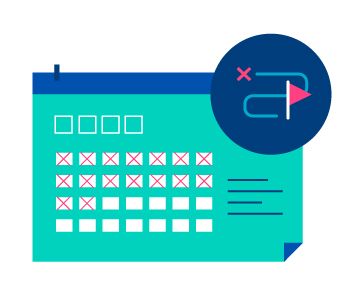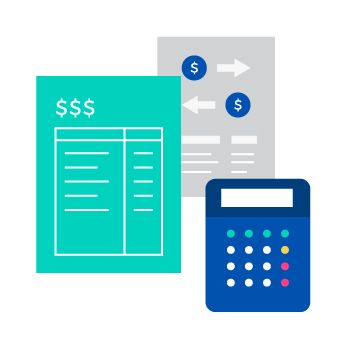How to Create a Sales Plan in 10 Steps (+ Free Template)

Contents
Every sales team has some sort of plan, even if it’s just “sell more of the product/service that you’re employed to sell.”
Yet without a codified sales plan, it can be difficult to give a sales team the motivation and purpose they need to successfully engage customers and continue to generate revenue.
Not having a sales plan that’s written down and signed off on by stakeholders can lead to confusion around what sales reps should and shouldn’t be doing, which can be demotivating.
It might seem daunting – or time-consuming – to put together an entire sales plan, but it doesn’t need to be. Here’s how to create a thorough sales plan in ten simple steps.
1. Decide on Your Timeline
 Setting goals and outlining tactics is not going to be productive if you’re not working towards a date by which you’ll measure your efforts.
Setting goals and outlining tactics is not going to be productive if you’re not working towards a date by which you’ll measure your efforts.
Determining the timeline of your sales plan should therefore be your number one consideration. When will you be ready to kick start your plan, and when is a reasonable time to measure the outcomes of your plan against your SMART goals?
Remember that you need to give the plan a chance to make an impact, so this timeline shouldn’t be too restrictive. However, you also want to make sure that you’re flexible enough to adjust your plan if it’s not producing the desired results.
Most sales plan timelines cover about a year, which may be segmented into four quarters and/or two halves to make it a little more manageable.
2. Outline the Context
Use the first page of your sales plan to outline the context in which the sales plan was created.
What is the current state of the organization? What are your challenges and pain points? What recent wins have you experienced?
Do you have tighter restrictions on cash flow, or does revenue appear to be growing exponentially? How is your sales team currently performing?
While you’ll discuss your business plan and roadmap later in the document, you can also outline the long-term vision for the business in this section. For example, where do you want to see the business in five years?
Comparing the current situation with your vision will emphasize the gap between where you are now and where you need to be, and will help inspire the sales plan.
3. Company Mission and Values
It’s essential that you put your mission and values at the heart of your business. You need to incorporate them into every function – and this includes your sales plan.
Outlining your mission and values in your sales plan ensures that you remember what the company is striving for, and in turn helps ensure that your approach and tactics will support these objectives.
Remember: a strong brand mission and authentic values will help boost customer loyalty, brand reputation, and ultimately sales.
4. Target Market and Product/Service Positioning
 Next, you’ll need to describe the market or markets that you’re operating in.
Next, you’ll need to describe the market or markets that you’re operating in.
What is your target market or industry? Then, note why: what research led you to conclude that this was the optimal market for you?
Who within this industry is your ideal customer? What are their characteristics? This could be job title, geographical location, and company size, for example. This information makes up your ideal customer profile.
If you’ve delved further into audience research and developed personas around your target market, then include them in here, too.
Finally, discuss where your product or service sits within the market. How is it positioned in terms of price point and quality? What are its USPs?
5. Sales Team and Resources
This step is simple: make a list of your sales resources, beginning with a short description of each member of your sales team.
Include their name, job title, length of time at the company, and – where appropriate – their salary. What are their strengths? How can they be deployed to help you hit your goals?
You should also include notes around the gaps in your sales team and whether you intend to recruit any new team members into these (or other) roles.
Then, list your other resources. These could be tools, software, or access to other departments such as the marketing team – anything that you intend to use in the execution of your sales plan. This is a quick way to eliminate any tools or resources that you don’t need.
6. Concurrent Activities
The next step in creating your sales plan involves providing an overview of non-sales activities that will be taking place during the implementation of your sales plan.
Any public marketing plans, upcoming product launches, or deals or discounts should be included, as should any relevant events. This will help you plan sales tactics around these activities and ensure that you’re getting the most out of them.
7. Business Roadmap
 For this step, write up an overview of the business’s overall roadmap, as well as the areas where sales activities can assist with or accelerate this plan. You’ll need to collaborate with the CEO, managing director, or board of directors in order to do this.
For this step, write up an overview of the business’s overall roadmap, as well as the areas where sales activities can assist with or accelerate this plan. You’ll need to collaborate with the CEO, managing director, or board of directors in order to do this.
In most cases, the business will already have a roadmap that has been signed off on by stakeholders. It’s the sales manager’s job to develop a sales plan that not only complements this roadmap, but facilitates its goals.
With this in mind, highlight areas of the roadmap that should be touchpoints for the sales team. What will your department need to do at each point in the roadmap to hit these overarching company goals?
8. Sales Goals and KPIs
Another important part of the sales plan involves your sales goals and KPIs.
Outline each goal, alongside the KPIs you’ll use to measure it. Include a list of metrics you’ll use to track these KPIs, as well as a deadline for when you project that the goal will be achieved.
It’s vital to make these goals tangible and measurable.
A bad example of a goal is as follows:
Goal 1: Increase sales across company’s range of products and services
A better goal would look something like:
Goal 1: Generate $500,000+ in revenue from new clients through purchases of X product by X date.
9. Action Plan
Now that you’ve laid out your goals, you need to explain how you will hit them.
Your action plan can be set out week by week, month by month, or quarter by quarter. Within each segment, you must list out all of the sales activities and tactics that you will deploy – and the deadlines and touchpoints along the way.
While this is arguably the most complex part of the sales plan, this is where sales leaders are strongest. They know best which approach will work for their team, their company, and their market.
10. Budget
 Budgets vary from team to team and company to company, but whatever your situation, it’s important to include your budget in your sales plan.
Budgets vary from team to team and company to company, but whatever your situation, it’s important to include your budget in your sales plan.
How are you going to account for the money spent on new hires, salaries, tech, tools, and travel? Where budget is tight, what are your priorities going to be, and what needs to be axed?
The budget section should make references back to your action plan and the “sales team and resources” page in order to explain the expenditures.
Sales Plan Template
Cover page
[Insert company name] Sales Plan
Timeline: [Start date]-[End date]
Created by: [Name]
Signed off by: [Names of stakeholders]
Page 1: Table of Contents
[Insert table of contents]
Page 2: Context
Answer the following questions:
- What is the state of the organization now?
- How is your sales team currently performing?
- What challenges is the organization facing?
- What challenges is the sales team facing?
Page 3: Mission and Values
[Insert company mission statement]
Value 1:
Value 2:
Value 3:
Value 4:
Value 5:
[Disclaimer that all sales activities should take place in line with these values and the spirit in which they are intended]
Page 4: Target Market and Product/Service Market Position
Target market/industry:
Positioning in industry:
Ideal customer profile:
Persona 1:
Persona 2:
Persona 3:
Persona 4:
Page 5: Sales Team and Resources
[Name]
[Job title]
[Duties and responsibilities]
[Length of time at company]
[Strengths]
Repeat the above for each team member.
List of extra resources (including cost):
Page 6: Concurrent Activities
Outline the following upcoming activities, alongside the dates. Highlight where sales team members should be involved.
Marketing activities:
Product launches:
Deals/discounts:
Events:
Page 7: Business Roadmap
[Insert business roadmap, as agreed upon by all relevant stakeholders]
Page 8: Sales Goals and KPIs
Sales goal 1:
Deadline:
KPI a:
KPI b:
KPI c:
Sales goal 2:
Deadline:
KPI a:
KPI b:
KPI c:
Sales goal 3:
Deadline
KPI a:
KPI b:
KPI c:
Page 9: Action Plan
- What actions will you take to hit sales goal 1?
- On which dates will you take these actions?
- Who will be the stakeholder for these actions?
- Who will be involved in these actions?
- What actions will you take to hit sales goal 2?
- On which dates will you take these actions?
- Who will be the stakeholder for these actions?
- Who will be involved in these actions?
- What actions will you take to hit sales goal 3?
- On which dates will you take these actions?
- Who will be the stakeholder for these actions?
- Who will be involved in these actions?
Page 10: Budget
[Overall budget for timeline]
Spend on salary:
[List other intended expenditure, with reference to action plan]
Budget rolled over:





